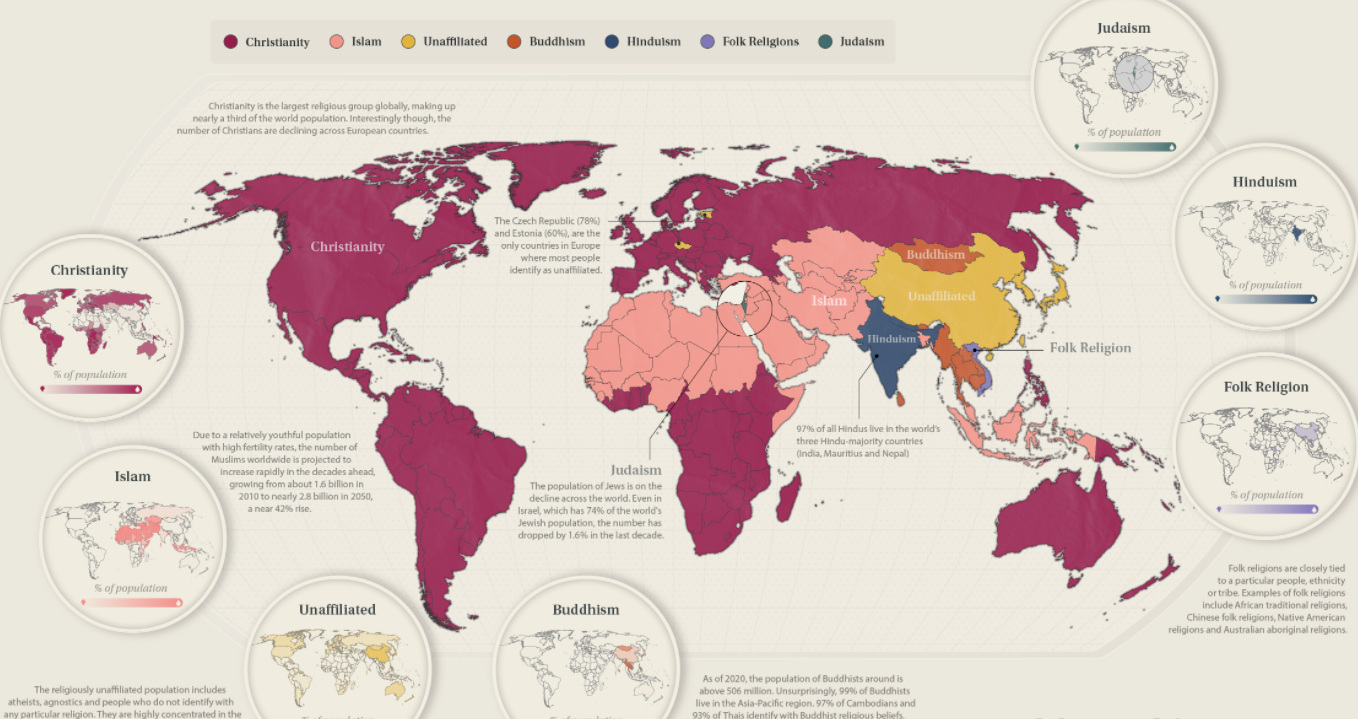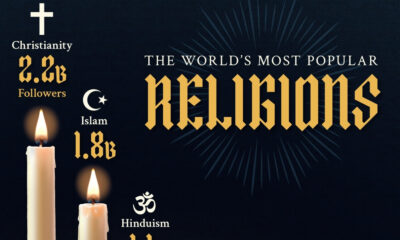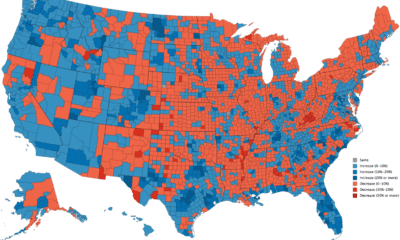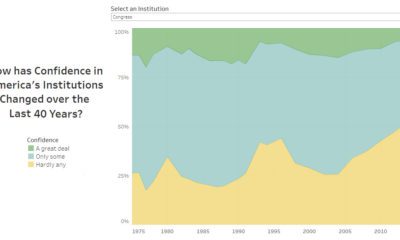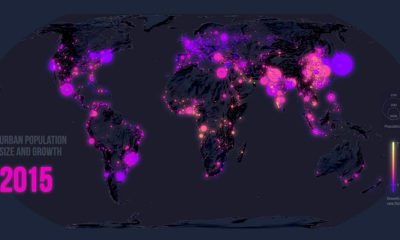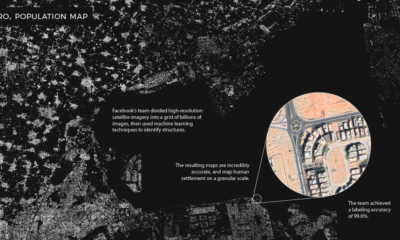Misc
Mapped: The World’s Major Religions
View the full-size infographic map
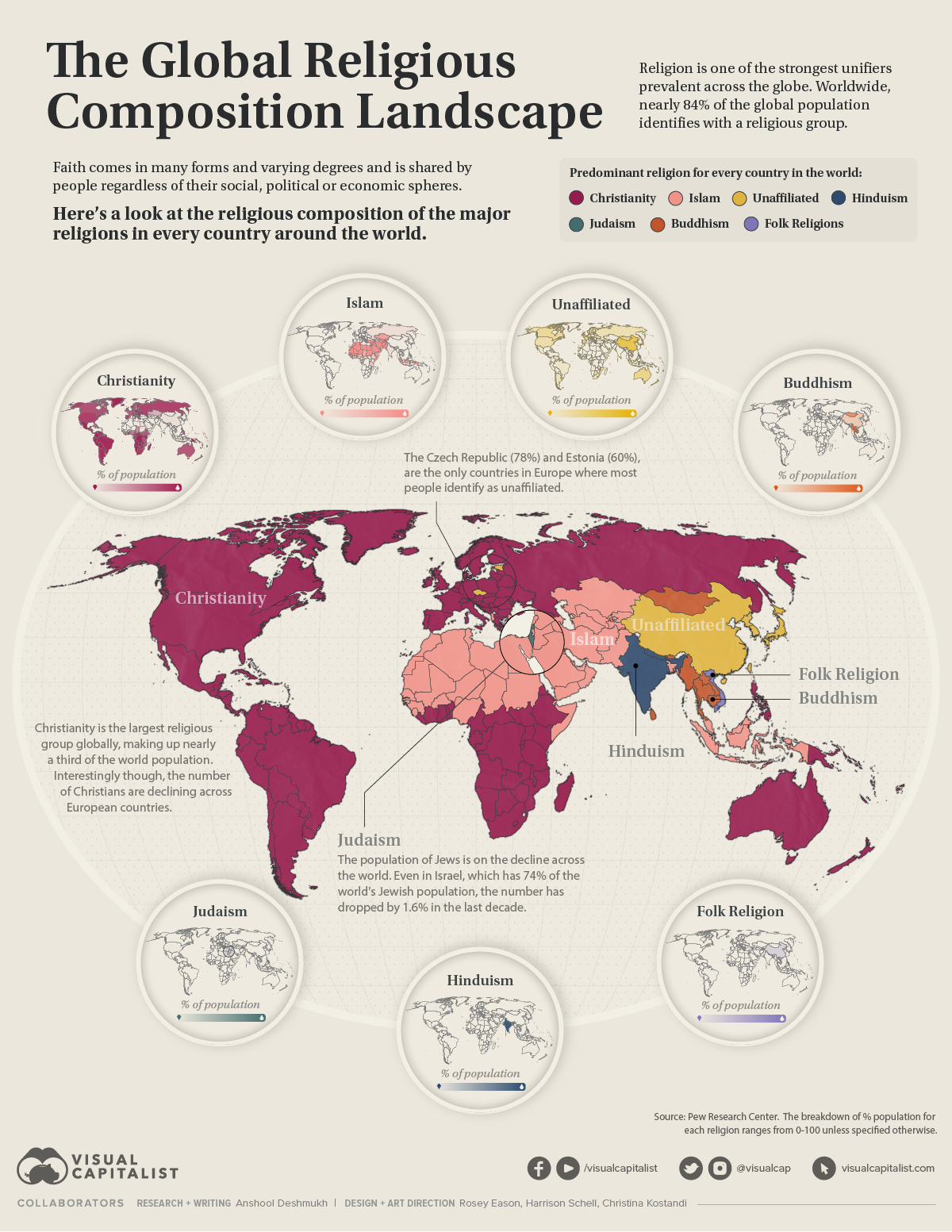
View the high-resolution version
Religious Composition of Countries
The world has become increasingly more secular in the last few decades. However, religion remains an integral part of many people’s lives, and 84% of the world’s population identifies with a religious group.
The religious profile of the world is rapidly changing, driven primarily by differences in fertility rates and the size of youth populations among the world’s major religions, as well as by people switching faiths.
With the help of data from Pew Research Center, we break down the religious composition of the major religions in countries worldwide.
Religious Makeup of the World by Major Religions
Determining the exact number of religions across the world is a daunting task. Many religions can be difficult to categorize or to tell apart for those not intimately familiar with their doctrine.
Pew Research Center organizes the world’s religions into seven major categories, which includes five major religions (Christianity, Islam, Buddhism, Hinduism, and Judaism), one category that broadly includes all Folk/Traditional religions, and an unaffiliated category.
Globally, Christianity has the largest following of these categories. Around 31% of the world’s population are Christians, closely followed by Muslims at 25%. Jews have the smallest population of major religions, with only 0.2% of the world identifying as Jewish.
Let’s take a look at the religious composition of the world when accounting for regions:
| Region | Christians | Muslims | Unaffiliated | Hindus | Jews | Buddhists | Folk |
|---|---|---|---|---|---|---|---|
| North America | 74.6% | 1.3% | 19.2% | 0.8% | 1.6% | 1.2% | 0.4% |
| Latin America-Caribbean | 89.7% | 0.1% | 8.0% | 0.1% | 0.1% | 0.1% | 1.8% |
| Europe | 72.2% | 6.8% | 20.0% | 0.2% | 0.2% | 0.2% | 0.1% |
| Middle East-North Africa | 3.6% | 93.1% | 0.6% | 0.6% | 1.6% | 0.2% | 0.3% |
| Sub-Saharan Africa | 62.0% | 31.4% | 3.0% | 0.2% | 0.1% | 0.1% | 3.2% |
| Asia-Pacific | 7.2% | 25.7% | 20.0% | 26.0% | 0.1% | 11.3% | 8.6% |
| World | 31.0% | 25.0% | 15.6% | 15.2% | 0.2% | 6.6% | 5.6% |
From Islam being the dominant religion in the Middle East to over 95% of Cambodians and Thais following Buddhism, here’s how prevalent every major religion in the world is.
Christianity
The world’s largest religion, Christianity, is practiced by about 2.4 billion people.
The country with the highest number of practicing Christians is the United States, with a Christian population of 253 million. Brazil and Mexico follow closely with 185 million and 118 million Christians, respectively.
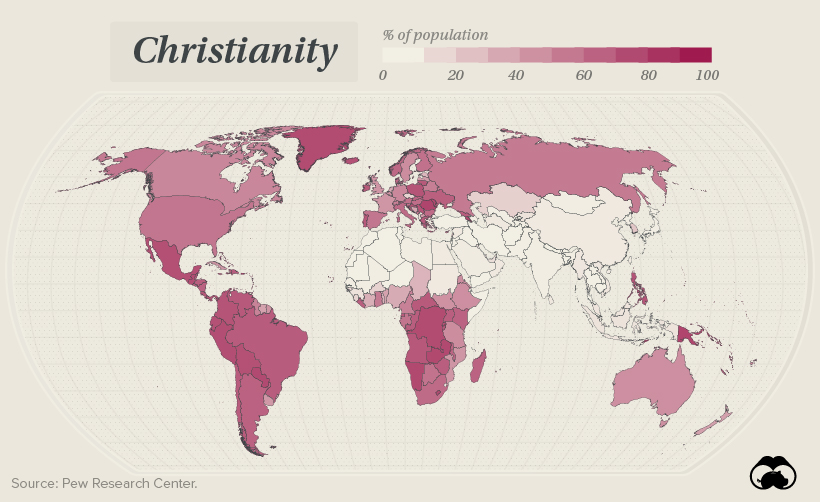
Christianity has historically spread around the globe and today it remains a geographically widespread religion. Over the past century, it has become less concentrated in Europe while becoming more evenly distributed throughout the Americas, sub-Saharan Africa, and the Asia-Pacific region.
Islam
Even though it’s the predominant religion of countries in the Middle East and Northern Africa, by sheer number, countries in Asia have the highest percentage of practicing Muslims in the world.
It may surprise you to know that 14.2% of Indians are Muslim. As a result, the country is home to one of the world’s largest Muslim populations, surpassed only by Indonesia.
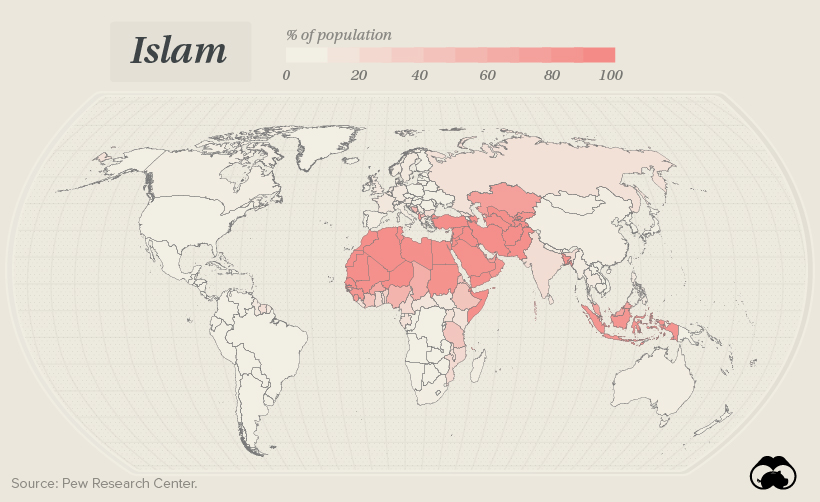
Islam is also the world’s fastest-growing major religion. The number of Muslims is expected to increase by 70%, from 1.8 billion in 2015 to nearly 3 billion in 2060. The fact that they have the youngest median age, at 24, also helps this population growth.
Judaism
While Jews historically have been found all around the globe, Judaism is highly geographically concentrated today. More than four-fifths of all Jews live in just two countries: the United States and Israel. Israel is the only country with a Jewish majority, with 76% of the population being practicing Jews.
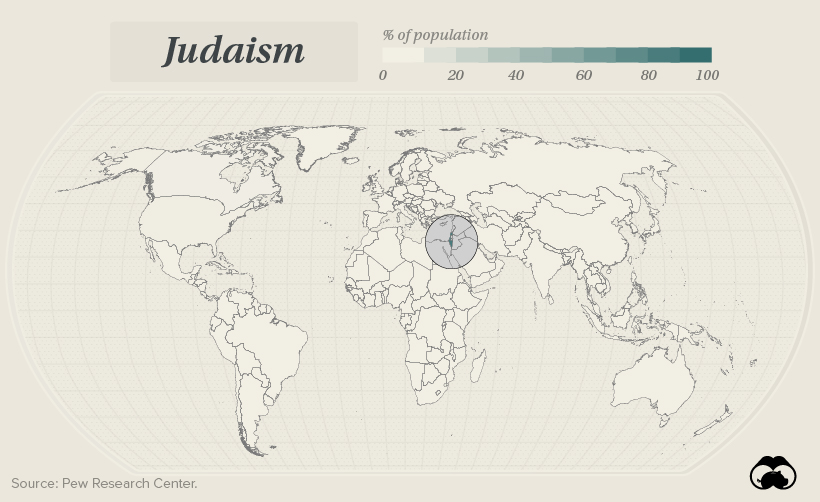
The largest remaining shares of the global Jewish population apart from the U.S. and Israel are in Canada (about 3% of the country’s population), France (2%), the United Kingdom (2%), Germany (2%), Russia (2%) and Argentina (between 1% and 2%).
Unaffiliated
The religiously unaffiliated population includes atheists, agnostics, and people who do not identify with any particular religion. 720 million of the Chinese population consider themselves religiously unaffiliated, while 78% of Czechs feel the same way.
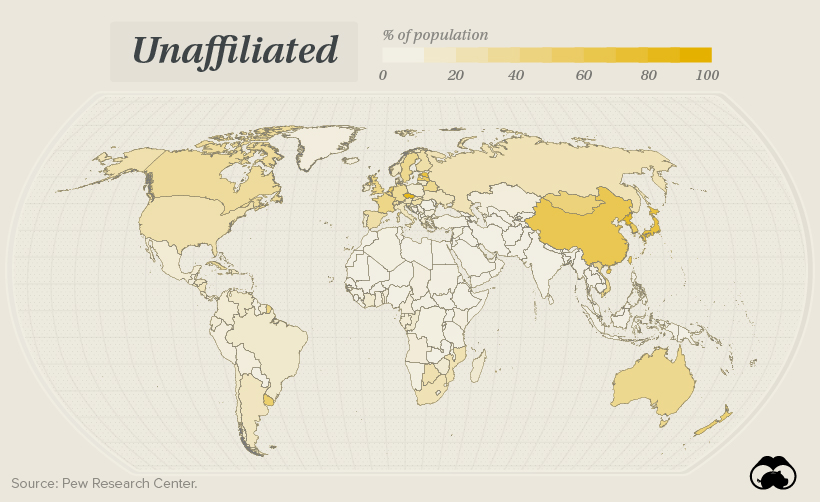
However, it is worth noting that many of the religiously unaffiliated hold some religious or spiritual beliefs. For example, surveys have found that faith in God or a higher power is shared by 7% of unaffiliated Chinese adults, 30% of unaffiliated French adults, and 68% of unaffiliated U.S. adults.
Hinduism
Hinduism is the third-largest religion worldwide, with approximately 1.2 billion Hindus in many countries. Interestingly, however, Hinduism is the dominant religion in only three countries, India with 79%, Nepal with 80%, and Mauritius with 48%.
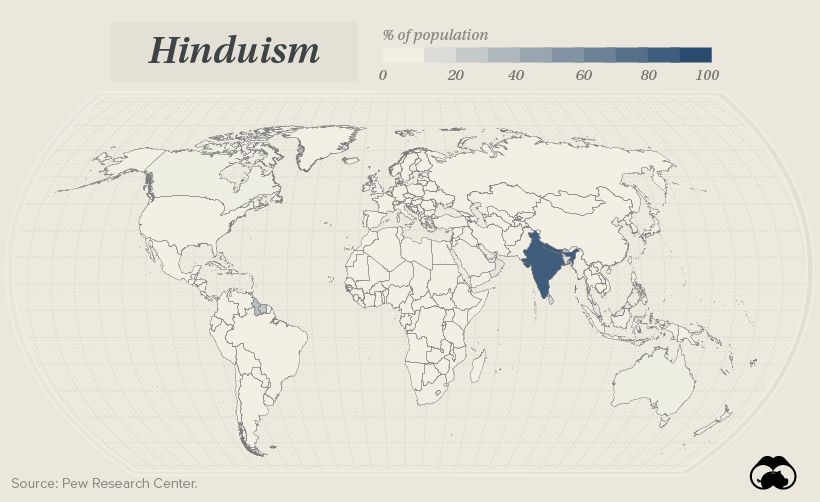
Although Hinduism is rarely a country’s primary religion, it still enjoys a global presence. Many regions around the world support significant populations of Hindus, including the Caribbean, Southeast Asia, North America, and South America.
Buddhism
According to estimates, half the world’s Buddhists live in China. Still, they make up only 18% of the country’s population. Most of the rest of the world’s Buddhists live in East and South Asia, including 13% in Thailand (where 93% of the population is Buddhist).
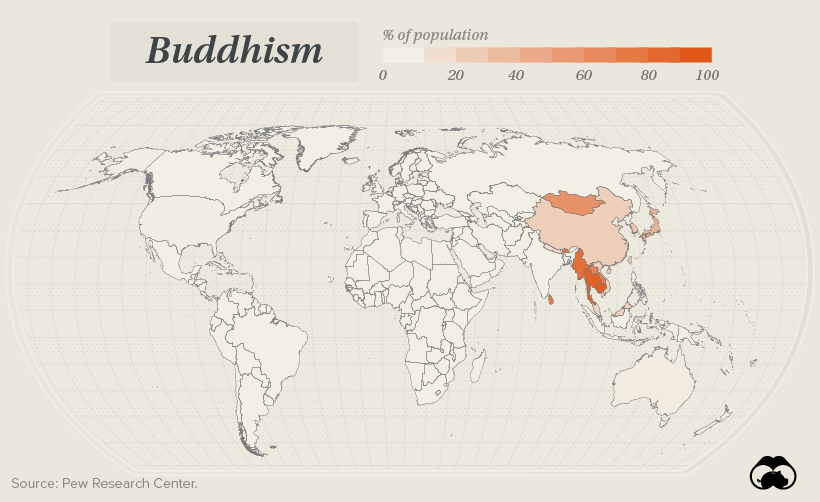
Buddhism in Asia is a matter of both identity and practice. Scholars and journalists have documented that many Asian countries may engage in Buddhist practices without considering themselves part of any organized religion.
Folk Religion
Folk religion is any ethnic or cultural religious practice that falls outside the doctrine of organized religion. Grounded on popular beliefs and sometimes called popular or vernacular religion, the term refers to how people experience and practice religion in their daily lives.
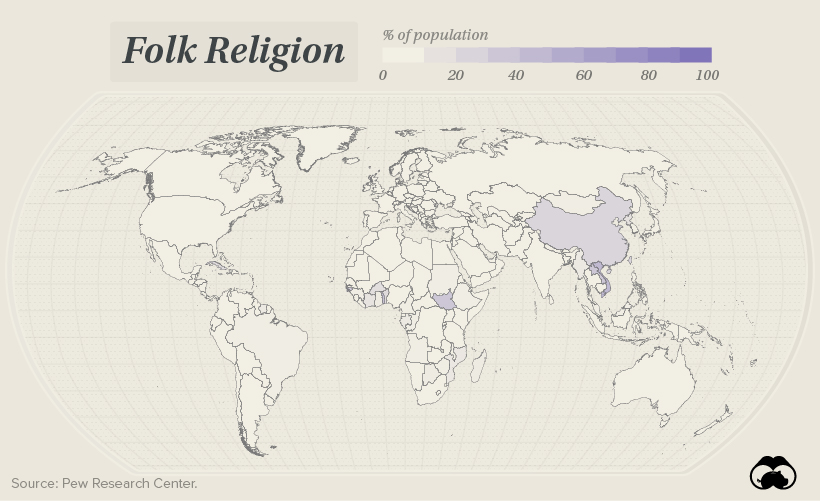
As of 2020, an estimated 429 million people, about 6% of the world’s total population, were adherents of folk or traditional religions. Some notable folk religions include African traditional religions, Chinese folk religions, Native American religions, and Australian aboriginal religions.
Misc
How Hard Is It to Get Into an Ivy League School?
We detail the admission rates and average annual cost for Ivy League schools, as well as the median SAT scores required to be accepted.

How Hard Is It to Get Into an Ivy League School?
This was originally posted on our Voronoi app. Download the app for free on iOS or Android and discover incredible data-driven charts from a variety of trusted sources.
Ivy League institutions are renowned worldwide for their academic excellence and long-standing traditions. But how hard is it to get into one of the top universities in the U.S.?
In this graphic, we detail the admission rates and average annual cost for Ivy League schools, as well as the median SAT scores required to be accepted. The data comes from the National Center for Education Statistics and was compiled by 24/7 Wall St.
Note that “average annual cost” represents the net price a student pays after subtracting the average value of grants and/or scholarships received.
Harvard is the Most Selective
The SAT is a standardized test commonly used for college admissions in the United States. It’s taken by high school juniors and seniors to assess their readiness for college-level academic work.
When comparing SAT scores, Harvard and Dartmouth are among the most challenging universities to gain admission to. The median SAT scores for their students are 760 for reading and writing and 790 for math. Still, Harvard has half the admission rate (3.2%) compared to Dartmouth (6.4%).
| School | Admission rate (%) | SAT Score: Reading & Writing | SAT Score: Math | Avg Annual Cost* |
|---|---|---|---|---|
| Harvard University | 3.2 | 760 | 790 | $13,259 |
| Columbia University | 3.9 | 750 | 780 | $12,836 |
| Yale University | 4.6 | 760 | 780 | $16,341 |
| Brown University | 5.1 | 760 | 780 | $26,308 |
| Princeton University | 5.7 | 760 | 780 | $11,080 |
| Dartmouth College | 6.4 | 760 | 790 | $33,023 |
| University of Pennsylvania | 6.5 | 750 | 790 | $14,851 |
| Cornell University | 7.5 | 750 | 780 | $29,011 |
*Costs after receiving federal financial aid.
Additionally, Dartmouth has the highest average annual cost at $33,000. Princeton has the lowest at $11,100.
While student debt has surged in the United States in recent years, hitting $1.73 trillion in 2023, the worth of obtaining a degree from any of the schools listed surpasses mere academics. This is evidenced by the substantial incomes earned by former students.
Harvard grads, for example, have the highest average starting salary in the country, at $91,700.
-

 Maps2 weeks ago
Maps2 weeks agoMapped: Average Wages Across Europe
-

 Money1 week ago
Money1 week agoWhich States Have the Highest Minimum Wage in America?
-

 Real Estate1 week ago
Real Estate1 week agoRanked: The Most Valuable Housing Markets in America
-

 Markets1 week ago
Markets1 week agoCharted: Big Four Market Share by S&P 500 Audits
-

 AI1 week ago
AI1 week agoThe Stock Performance of U.S. Chipmakers So Far in 2024
-

 Automotive2 weeks ago
Automotive2 weeks agoAlmost Every EV Stock is Down After Q1 2024
-

 Money2 weeks ago
Money2 weeks agoWhere Does One U.S. Tax Dollar Go?
-

 Green2 weeks ago
Green2 weeks agoRanked: Top Countries by Total Forest Loss Since 2001




